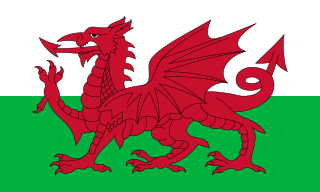
In Welsh culture, an eisteddfod is a festival with several ranked competitions, including in poetry and music. The term eisteddfod, which is formed from the Welsh morphemes: eistedd, meaning 'sit', and fod, meaning 'be', means, according to Hywel Teifi Edwards, "sitting-together." Edwards further defines the earliest form of the eisteddfod as a competitive meeting between bards and minstrels, in which the winner was chosen by a noble or royal patron.

The Oxford Book of Welsh Verse in English was a 1977 poetry anthology edited by the author and academic Gwyn Jones. It covered both Welsh language poetry, in English translation, and Welsh poets writing in English.
This article is about the particular significance of the year 2005 to Wales and its people.

Rhisiart Gwyn, also known by his anglicised name, Richard White, was a Welsh teacher at illegal and underground schools and a Bard who wrote both Christian and satirical poetry in the Welsh language. A Roman Catholic during the reign of Queen Elizabeth I of England, Gwyn was martyred by being hanged, drawn and quartered for high treason at Wrexham in 1584. He was canonised by Pope Paul VI in 1970 as one of the Forty Martyrs of England and Wales. Since its creation in 1987, St. Richard Gwyn has been the Patron Saint of the Roman Catholic Diocese of Wrexham. Along with fellow lay martyr St. Margaret Clitherow, Gwyn is the co-patron of the Latin Mass Society of England and Wales.
This article is about the particular significance of the year 1990 to Wales and its people.
This article is about the particular significance of the year 1979 to Wales and its people.
This article is about the particular significance of the year 1975 to Wales and its people.
This article is about the particular significance of the year 1964 to Wales and its people.
The Wales Book of the Year is a Welsh literary award given annually to the best Welsh and English language works in the fields of fiction and literary criticism by Welsh or Welsh interest authors. Established in 1992, the awards are currently administered by Literature Wales, and supported by the Arts Council of Wales, Welsh Government and the Welsh Books Council.

Rowen is a village on the western slopes of the Conwy valley in the parish of Caerhun and the former County of Caernarfonshire in Wales. It lies off the B5106 road, between Tal y Bont and the Groes Inn. Buildings of Gwynedd 2009 refers to the River Roe probably following the Roman route from Caerhun to Abergwyngregyn. Rowen has won tidiest village awards several times.
The syntax of the Welsh language has much in common with the syntax of other Insular Celtic languages. It is, for example, heavily right-branching, and the verb for be is crucial to constructing many different types of clauses. Any verb may be inflected for three tenses, and a range of additional tenses are constructed with auxiliary verbs and particles. Welsh lacks true subordinating conjunctions, and instead relies on special verb forms and preverbal particles to create subordinate clauses.
Steve Eaves is a Welsh poet, songwriter and singer, working in the Welsh language. He has lived for most of his life in the Bangor area of North Wales. He has been a performing musician for over 45 years. During the late 1960s and early 1970s he worked as a labourer and musician, with frequent forays to Chester, Crewe and other locations to perform at folk clubs and underground venues of the period. He also performed at the now legendary Les Cousins folk club in Soho, sharing the floor spot with legendary blues singer Jo Ann Kelly. He also performed with various 'underground' luminaries of the time such as Al Stewart, Tea and Symphony, and the Sutherland Brothers.
This article is about the particular significance of the year 2009 to Wales and its people.

Under Milk Wood is a 1972 British drama film directed by Andrew Sinclair and based on the 1954 radio play Under Milk Wood by the Welsh writer Dylan Thomas, commissioned by the BBC and later adapted for the stage. It featured performances by Richard Burton, Elizabeth Taylor, Siân Phillips, David Jason, Glynis Johns, Victor Spinetti, Ruth Madoc, Angharad Rees, Ann Beach, Vivien Merchant and Peter O'Toole as the residents of the fictional Welsh fishing village of Llareggub.

Salem is a painting of 1908 by the English painter Sydney Curnow Vosper, depicting a scene within Capel Salem, a Baptist chapel in Pentre Gwynfryn, Gwynedd, Wales. It is noteworthy as a depiction of Welsh piety, the traditional Welsh national costume, and for a contentious belief that the devil is depicted within it. Mass reproductions throughout the early and mid 20th century ensured that the image became famous throughout Britain.
Gwynn, Gwynne, Guinn or Gwyn, are given names meaning "white" or/and "blessed" in Welsh and Cornish.






